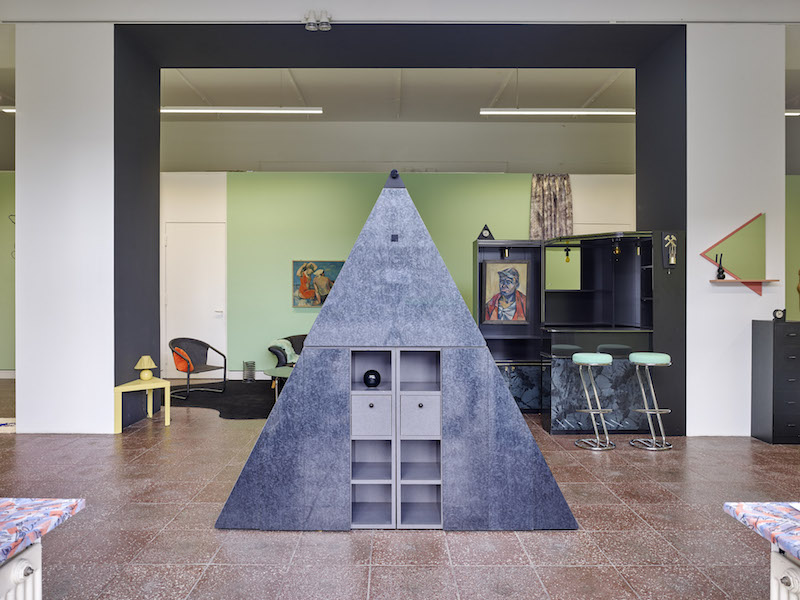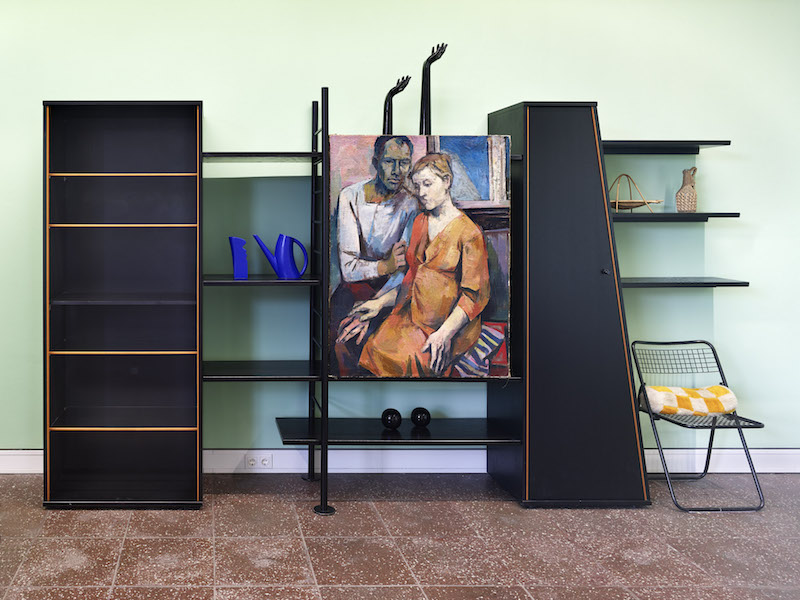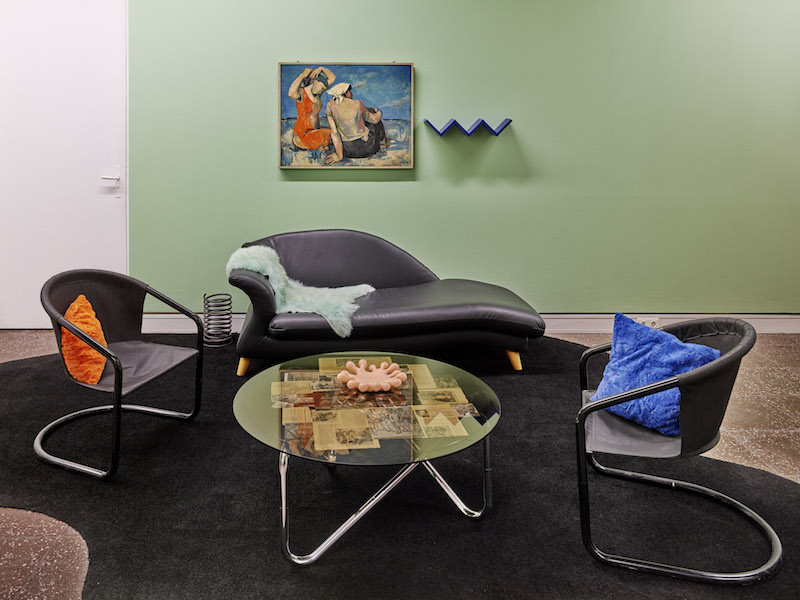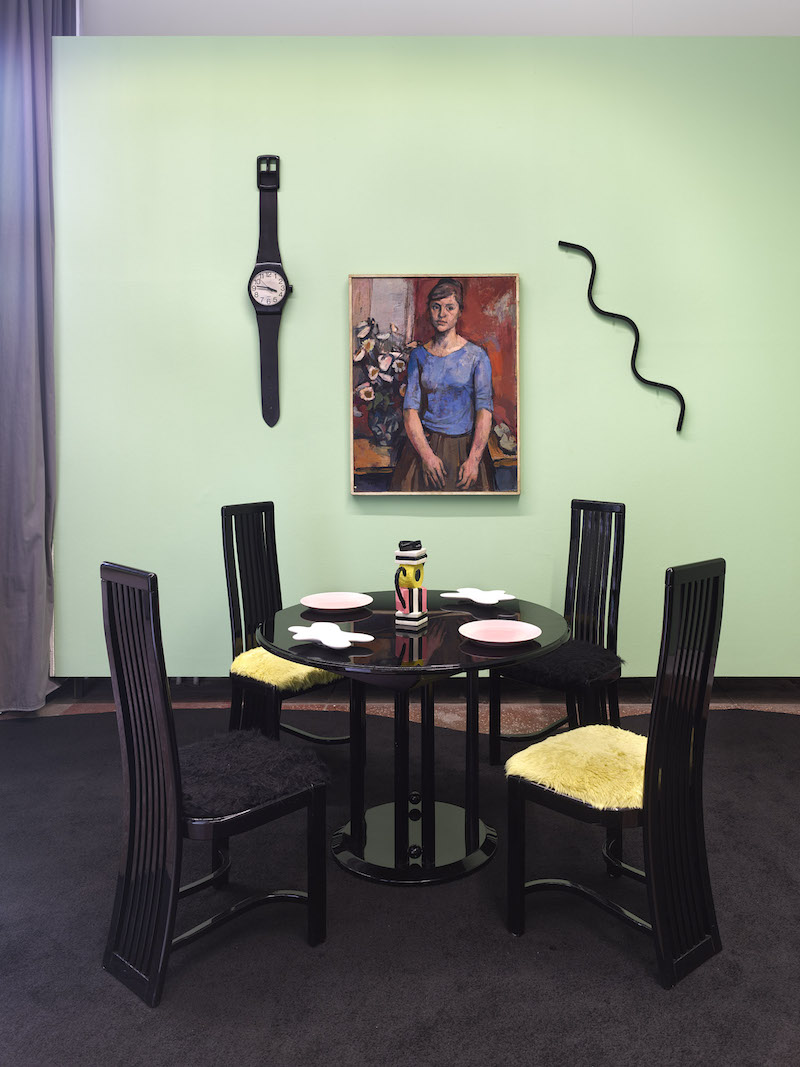Article by Nina Prader // Nov. 23, 2018
In Henrike Naumann’s carefully staged interiors, memory, amnesia and the present seem indiscernible, simultaneously as flippant as they are nostalgically potent. Her sculptural environments show ideologies, embedded in materials such as found footage and found objects. Calling to mind walk-through furniture catalogs or a real-estate viewing, these spaces are private interiors reconceived as historical monuments. Throughout her oeuvre, Naumann critically and cinematically unpacks East German identity in the shift from the GDR to the present. What does it even mean to be a contemporary German? In her most recent exhibition, ‘DDR Noir: Schichtwechsel’ at Galerie im Turm, the characteristic set of cinematic signifiers and triggers confront us with crucial questions: to whom does this space belong? Who lived here, and when?

Henrike Naumann, DDR Noir: Schichtwechsel, 2018, Installation view Galerie im Turm // Courtesy Nele Jakob, Daniel Jakob, Henrike Naumann and KOW Berlin, Photo: Eric Tschernow
Recently, as part of KOW gallery’s group show ‘Was euch am Leben hält, ist, was bei uns zu Asche zerfällt *’—positioning itself against the fascist uprisings in Chemnitz, Saxony—Naumann exhibited a four-room installation. Each section presented lifestyle fragments of Germans with right-wing inclinations. From a bird’s eye perspective, the walls shape-shifted into a walk-in Swastika. The decor on display captured the esoteric tendencies behind rightwing beliefs. A vitrine housed a paperweight stone egg—that hopefully won’t hatch—and iron candelabra—the equivalent of crystals and incense—Aryan documents, surrounded by a nasty, fleshy wallpaper, in addition to mp3 sound files of violent techno and white German men lamenting the “Heimat”.
Born in Zwickau, Saxony—the area notorious for the neo-Nazi underground terrorist group NSU—in the 1980s, Naumann’s upbringing gives her the intuitive sensibility to capture the shifts that the East German worker faced from the fall of the wall to the present. By encountering these spaces, manifesting the right-wing other, she reveals a material portrait with discrete criticality.

Henrike Naumann, DDR Noir: Schichtwechsel, 2018, Installation view Galerie im Turm // Courtesy Nele Jakob, Daniel Jakob, Henrike Naumann and KOW Berlin, Photo: Eric Tschernow
Unpacking Naumann’s roster of materials, it is not surprising to find that she has a background in stage and film set-design and comes from a lineage of artists. Her grandmother decorated vitrines and her grandfather, Karl Heinz Jakob, was a painter, whose paintings are currently on view alongside her work in ‘DDR Noir: Schichtwechsel’. Naumann creates a reactive setting for his socialist realist canvases, seamlessly absorbing them onto the walls while making a pointed commentary about their time and place. On a shelf, kitschy ceramic hands seem to reach out of the heads of his portraits.

Henrike Naumann, DDR Noir: Schichtwechsel, 2018, Installation view Galerie im Turm // Courtesy Nele Jakob, Daniel Jakob, Henrike Naumann and KOW Berlin, Photo: Eric Tschernow
Reoccurring patterns in Naumann’s work include fuzzy carpets, wallpapers in otherworldly colors, clocks and geometric wall cabinets. The domestic drapes and upholstery decorating these abstract spaces become public and private memorials, elevating the living room to a historical context. On one hand, there is a kind of othering of the East German subject as exotic, while on the other hand, the textiles and patterns are eminently relatable. In Naumann’s interiors, the rupture that occurred with the fall of the wall is made palpable, even to a new Berliner millennial.

Henrike Naumann, DDR Noir: Schichtwechsel, 2018, Installation view Galerie im Turm // Courtesy Nele Jakob, Daniel Jakob, Henrike Naumann and KOW Berlin, Photo: Eric Tschernow
The negative spaces of her scenography, meant to be inhabited, become positives in the way the viewer engages with them. Visitors are too shy to sit at the dining table, for example. Presented in the art context, the pleather couch becomes even more uncomfortable. Instead, distracted, we get absorbed in newspaper clippings of socialist art reviews, criticizing her grandfather for not completely adhering to socialist realist principles. At the opening, with visitors positioned at arms-length from the furniture, looking on as if it were a time capsule, ghosts began to gather on the carefully-constructed stages. Fittingly, Wilhelm Klotzek enacted specters with songs from his album, Bonn, Beuel, Tannenbusch Henry Moore & Ich. Waves of smoke-machine fog lapped at his feet and filled the fragmented rooms in a real-time dream sequence, a history lesson in German mise-en-scène.
Exhibition Info
GALERIE IM TURM
Henrike Naumann: ‘DDR Noir: Schichtwechsel’
Exhibition: Nov. 09, 2018–Jan. 06, 2019
Frankfurter Tor 1, 10243 Berlin, click here for map




















